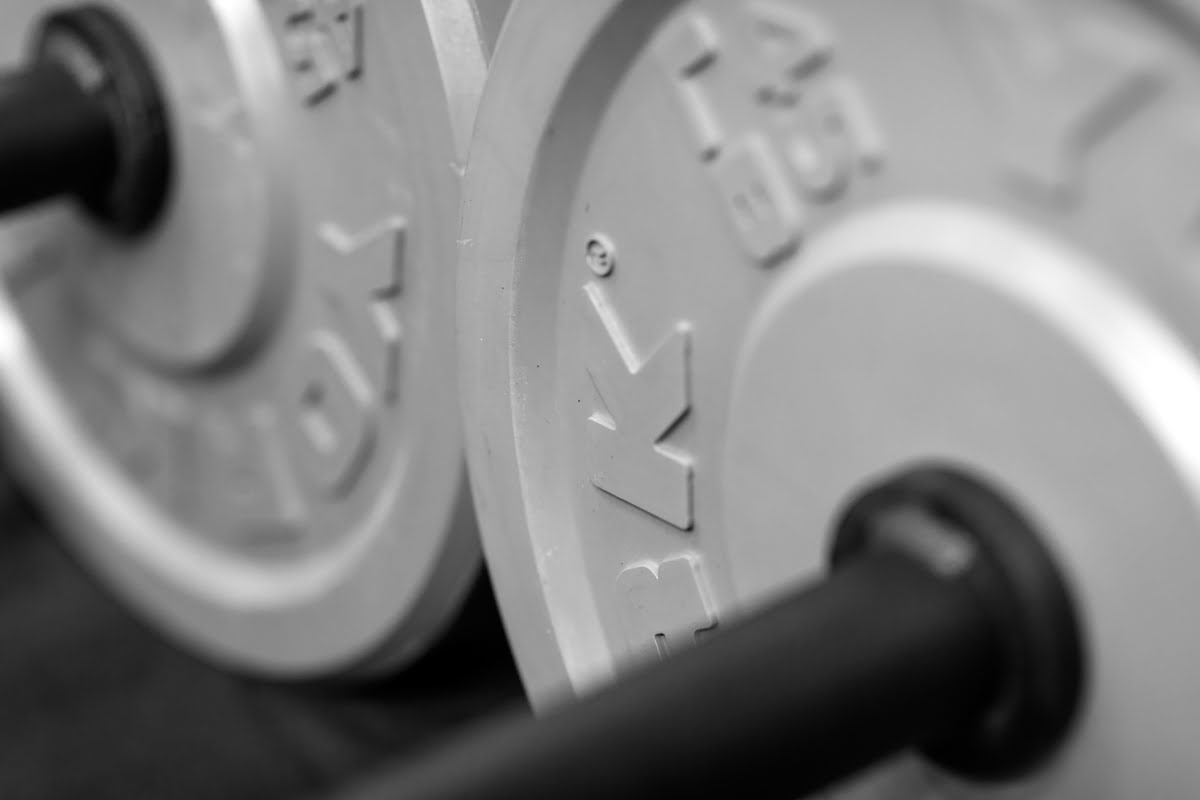
What do the push up, the deadlift, the squat and the shoulder press all have in common? They are the types of movements you encounter in your activities of daily living, work, and recreation. It is for this exact reason that it is important to properly master these movements, as their proper execution will lead to more efficient movement in any of the physical activities you undertake. Remember that these are the movements that are most used in training because they solicit many groups of muscles simultaneously.
The shoulder press is an important upper body strength movement. It is also a lot more technical than it seems. The arms work synergistically with many other muscle groups in order to generate the greatest strength on the barbell as well as the greatest stability at the feet. In order to do this, an important principle needs to be applied: torque. Torque refers to the external rotation we create at the shoulders and the hips which both stabilizes and protects these joints. The more stable a joint, the greater the strength potential. This principle not only applies to the shoulder press, but to any movement.
When performing the shoulder press, the goal is to position and engage the body in such a way to create a vertical trajectory for the barbell, with the bar travelling from the shoulders to the overhead position. Several errors can be observed when insufficient torque is created in the shoulders and/or hips, and/or when the speed of execution is too rapid (often observed in Crossfit training). The shoulder press requires significant and appropriate core activation and mobility/flexibility of the shoulders and thoracic spine.
Here are 5 mistakes to avoid when executing the shoulder press. They are classified according to the region in which they occur: feet, hips/pelvis, elbows, wrists, neck:
Mistake #1.1 : Foot stance too narrow (less than hip width)

Mistake #1.2 : Foot stance too wide (greater than shoulder width)

In both cases, the position of the feet does not allow for an optimal support on the ground because it lacks stability. These positions do not allow for maximal engagement of the glutes (specifically glute med) to brace the lower body.
The optimal foot position is hip width or slightly wider, which increases glute med contraction (torque).
Mistake #2.1 : Anterior pelvic tilt

Mistake #2.2 : Posterior pelvic tilt

Posterior pelvic tilt is the opposite of anterior pelvic tilt. It creates flexion in the lumbar spine, also generating pressure on the intervertebral discs, pushing them posteriorly. It can also be caused by a motor control and/or a posture problem.
In order to position the pelvis in an optimal position, the abdominals must be braced (a feeling of “tightening” the abs) and engage the glute med (torque). This will position the pelvis in a neutral position, which is safer and more stable. Note that both mistakes (2.1 and 2.2.) can be observed either at the starting position, during execution, and/or in the end position of the shoulder press.
Mistake #3.1 : Internal rotation of the shoulders

If the elbows are pointing towards the outside, you will observe internal rotation at the shoulders. In this position, you risk compressing the soft tissues and bony structures in this region. Often, a lack of mobility/flexibility in external rotation is the main culprit, but it could also be due to shoulder instability and/or lack of motor control. We often observe this mistake during execution, with the elbows moving outwards during the middle phase of the press: there is loss of torque.
Mistake #3.2 : Elbows behind the bar in the starting position

Mistake #3.3 : Elbows in front rack position (hands not closed on the bar)
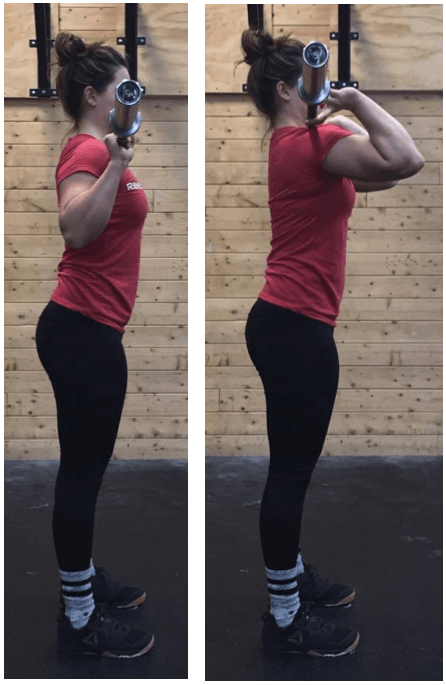
Mistake #3.2 : If the lats are not engaged, it is not possible to place the elbows under the bar, which minimizes the potential to generate strength. The trajectory of the bar becomes circular rather than vertical, and the bar tends to move away from the body during execution. This can generate lumbar hyperextension and/or lead to mistake #3.1 in mid-phase.
Mistake #3.3 : When you’ve only got 2 or 3 fingers around the bar, you cant’ get maximal lats contraction. What’s more, grip strength is greatly reduced, affecting the starting position, the strength generated during execution and stability in the end position.
It is important to remember that the starting position for the shoulder press is not the same as that of the front squat.
For an optimal starting position, the elbows should be placed under or slightly forward of the bar, and slightly tucked inwards (creating external rotation at the shoulders). The hands should have a full grip on the bar (all fingers around the bar). These two technical points are important for optimal lats engagement and to create the most vertical trajectory for the bar.
Mistake #4.1 : Hyperextension of the wrists
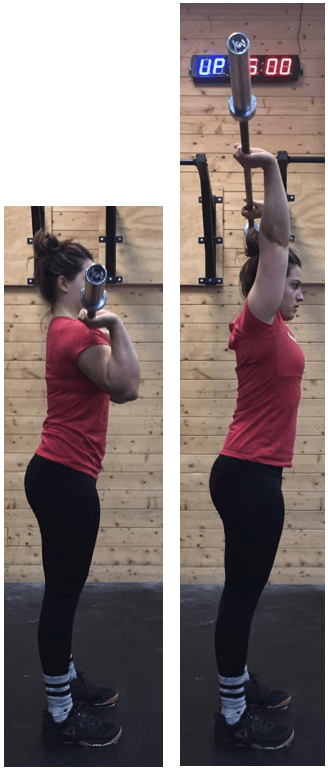
This may be caused by not having a full grip on the bar, and will lead to mistake #3.3. We often observe this position in the wrists at the end of the movement, when the barbell is overhead. This creates undue pressure on the wrists and can lead to pain. Poor motor control and/or a weak grip can be the cause.
Mistake #4.2 : Flexion of the wrists
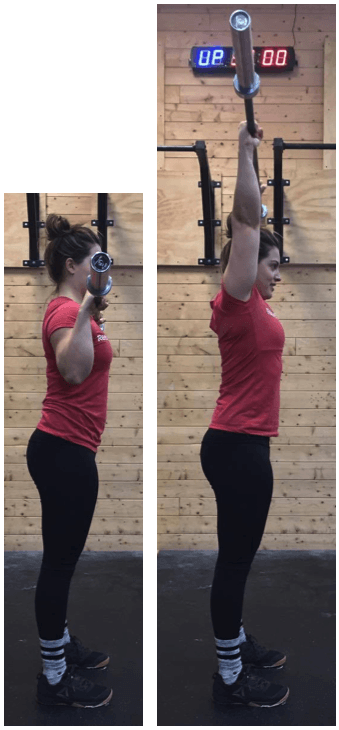
Flexion of the wrist is the opposite of extension. We observe this more often than not in the end position of the movement.
The optimal position for the wrists is in slight extension, both in the starting and end position.
Mistake #5.1 : Extension of the neck
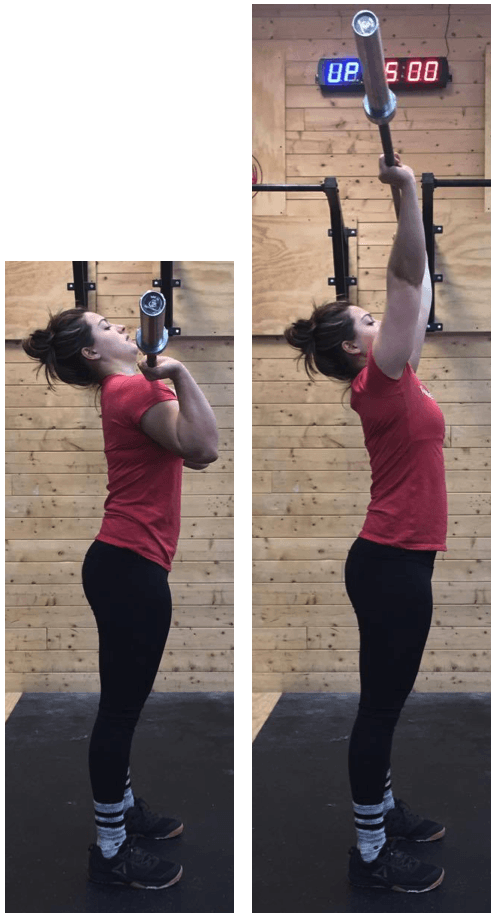
Extending the neck can create cervical hyperextension generating pressure on the intervertebral discs. This position is often due to a posture problem and/or a motor control problem. We often observe this position when the bar is being pressed in front of the body and overhead. This sub-optimal bar trajectory could be caused by a lack of shoulder and/ or thoracic spine mobility/flexibility.
Mistake #5.2 : Flexion of the neck

We often observe neck flexion near the end of the movement in an effort to complete the repetition. This position can also create pressure on the intervertebral discs.
Mistake #5.3 : Protraction of the neck in the end position

Neck protraction (pushing the chin forward) is a common mistake found in many athletes. We observe this at the end of the movement for the same reason as Mistake #5.2. It can also generate pressure on the intervertebral discs and is often caused by a lack of endurance of the deep neck flexors. Bad posture can transfer quickly to this type of movement.
Optimally, there is a slight neck retraction (pulling the chin back) in the starting position, so that the bar can move in the most vertical path possible. In the end position, the neck is simply in a neutral position (aligned with the vertical axis of the body).
Standard shoulder press
- Feet hip width or slightly wider
- Neutral pelvis (torque at the hips), glute med engaged
- Core braced
- Elbows under the bar or slightly ahead of it, shoulders externally rotated (torque)
- At mid-point, elbows pointing forward (torque maintained)
- Wrists in slight extension at the starting and end position
- Slight neck retraction in the starting position, neutral head position in the end position

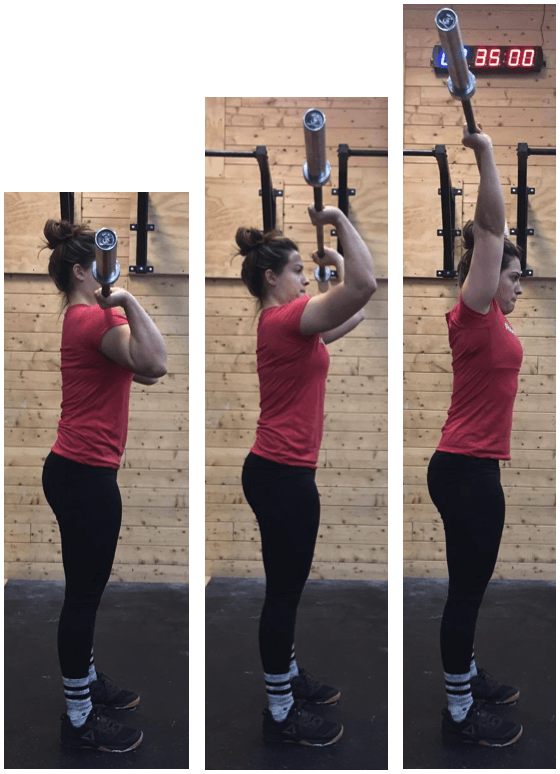
Corrective Exercise : Shoulder press with elastic band
Here is a handy corrective exercise for the shoulder press. An elastic band (light to moderate resistance) will allow you to really feel the effect of the torque you create at the hips and shoulders. At the feet, the elastic should always be tensed to the ground. At the shoulders, you should be thinking of tearing the elastic apart at the front. Throughout the movement as well as at the end position, the elastic will provide feedback on the trajectory that was generated: if the elastic moves away from the body’s vertical axis indicates sub-optimal strength production and is a clue that one or more technical points are lacking.
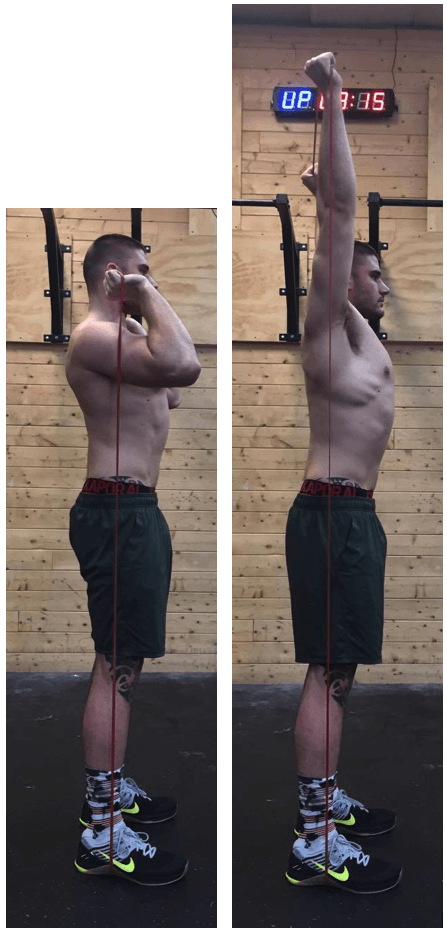
— AG
ABOUT ALEXANDRA GENDRON
Alexandra Gendron is a kinesiologist and a certified Crossfit Level 2 coach who specialises in teaching the olympic lifts with an emphasis on how to apply them to Crossfit performance. She has been a Crossfit athlete for five years and is thoroughly in loved with olympic lifting! Her passion for perfecting movement patterns has led her past the simple athlete stage and she progressed to coaching. She began coaching Crossfit in 2013 and since that day she has been looking for ways to improve her knowledge and skills as a coach. She has collaborated with many people in the field and assists Christian Thibaudeau in olympic lifting clinics. In 2015 she was instrumental in starting the first olympic lifting classes offered by Laval University. As a true training geek she loves to share her knowledge and know-how via her private coaching business, AGKIN. You can reach her at alexandragendron18@gmail.com
Комментариев нет:
Отправить комментарий